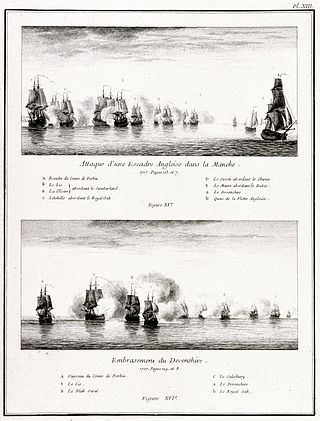HMS Antelope was a 50-gun fourth rate ship of the line of the Royal Navy, launched at Rotherhithe on 13 March 1703. She was rebuilt once during her career, and served in the Seven Years' War and the American Revolutionary War.

Claude, comte de Forbin-Gardanne was a French Navy officer, nobleman and diplomat. From 1685 to 1688, he led a diplomatic mission to the Ayutthaya Kingdom. He became governor of Bangkok and a general in the Siamese army, and left Siam shortly before King Narai fell ill and was deposed by the 1688 coup d'état. Returning to Europe, he got involved in the Nine Years' War and the War of the Spanish Succession.

HMS Lion was a 64-gun third-rate ship of the line of the Royal Navy, of the Worcester class, launched on 3 September 1777 at Portsmouth Dockyard.

The naval Battle of the Lizard took place on 21 October 1707 during the War of the Spanish Succession near Lizard Point, Cornwall between two French squadrons under René Duguay-Trouin and Claude de Forbin and an English convoy protected by a squadron under Commodore Richard Edwards.

The action of 25 September 1806 was a naval battle fought during the Napoleonic Wars off the French Biscay port of Rochefort. A French squadron comprising five frigates and two corvettes, sailing to the French West Indies with supplies and reinforcements, was intercepted by a British squadron of six ships of the line that was keeping a close blockade of the port as part of the Atlantic campaign of 1806. The British ships, under the command of Commodore Sir Samuel Hood, spotted the French convoy early in the morning of 25 September, just a few hours after the French had left port, and immediately gave chase. Although the French ships tried to escape, they were heavily laden with troops and stores, and the strong winds favoured the larger ships of the line, which caught the French convoy after a five-hour pursuit, although they had become separated from one another during the chase.

Admiral Sir William Cornwallis, was a Royal Navy officer. He was the brother of Charles Cornwallis, 1st Marquess Cornwallis, British commander at the siege of Yorktown. Cornwallis took part in a number of decisive battles including the siege of Louisbourg in 1758, when he was 14, and the Battle of the Saintes but is best known as a friend of Lord Nelson and as the commander-in-chief of the Channel Fleet during the Napoleonic Wars. He is depicted in the Horatio Hornblower novel, Hornblower and the Hotspur.

Julien Marie Cosmao-Kerjulien was a French Navy officer best known for his actions during the Battle of Trafalgar.
Edward Acton was a captain in the Royal Navy, distinguished for services in the reign of Queen Anne.

HMS Salisbury was a 50-gun fourth rate ship of the line of the Royal Navy, one of eight such ships authorised by the Navy Board on 24 December 1695 to be newly built ; the others were the Hampshire, Dartmouth, Winchester, Worcester, Jersey, Carlisle and Tilbury. The contract for the Winchester was signed with shipbuilders Richard and James Herring in 1696, for the ship to be built in their yard at Baileys Hard on the Beaulieu River in Hampshire, England, and she was launched there on 18 April 1698.

HMS Hampton Court was a 70-gun third rate ship of the line of the Royal Navy, launched at Deptford Dockyard in 1678. Her initial commission was to move her to Chatham where she spent in the next ten years in Ordinary. She held an active commission for the War of the English Succession, participating in the Battles of Beachy Head and Barfleur. She was rebuilt at Blackwall in 1699/1701. During the War of Spanish Succession she served mainly in the Mediterranean. In 1707 she was taken by the French and incorporated into the French Navy for four years. She was sold to the Spanish in 1712. She was wrecked in Spanish service off the coast of Florida in a hurricane in 1715.
HMS Grafton was a 70-gun third rate built at Woolwich Dockyard in 1677/79. She was delivered to Chatham and placed in Ordinary in 1679. She was commissioned in 1683 to participate in the evacuation of Tangier, Morocco. She served during the War of the English Succession fighting in the Battles of Beachy Head and Barfleur. She was rebuilt in 1699/1701. She was in active commission during the War of Spanish Succession. She fought in the Battle of Vigo, the capture of Gibraltar and the Battle of Velez Malaga. She was taken by the French in 1707 and incorporated into the French Navy. Finally, being broken at Brest in 1744.

The Atlantic campaign of 1806 was one of the most important and complex naval campaigns of the post-Trafalgar Napoleonic Wars. Seeking to take advantage of the withdrawal of British forces from the Atlantic in the aftermath of the Battle of Trafalgar, Emperor Napoleon ordered two battle squadrons to sea from the fleet stationed at Brest, during December 1805. Escaping deep into the Atlantic, these squadrons succeeded in disrupting British convoys, evading pursuit by British battle squadrons and reinforcing the French garrison at Santo Domingo. The period of French success was brief: on 6 February 1806 one of the squadrons, under Vice-Admiral Corentin Urbain Leissègues, was intercepted by a British squadron at the Battle of San Domingo and destroyed, losing all five of its ships of the line.

Captain Seth Jermy (1653–1724) was an officer of the Royal Navy, famous for fighting a particularly hard-fought action against an overwhelming French force while commander of HMS Nightingale.

The Atlantic campaign of 1806 was a complicated series of manoeuvres and counter-manoeuvres conducted by squadrons of the French Navy and the British Royal Navy across the Atlantic Ocean during the spring and summer of 1806, as part of the Napoleonic Wars. The campaign followed directly from the Trafalgar campaign of the year before, in which the French Mediterranean fleet had crossed the Atlantic, returned to Europe and joined with the Spanish fleet. On 21 October 1805, this combined force was destroyed by a British fleet under Lord Nelson at the Battle of Trafalgar, although the campaign did not end until the Battle of Cape Ortegal on 4 November 1805. Believing that the French Navy would not be capable of organised resistance at sea during the winter, the First Lord of the Admiralty Lord Barham withdrew the British blockade squadrons to harbour. Barham had miscalculated – the French Atlantic fleet, based at Brest, had not been involved in the Trafalgar campaign and was therefore at full strength. Taking advantage of the reduction in the British forces off the port, Napoleon ordered two heavy squadrons to sea, under instructions to raid British trade routes while avoiding contact with equivalent Royal Navy forces.

Several ships of the French Navy have borne the name Mars, after Mars, the Roman god of war:
Admiral Thomas Le Marchant Gosselin was a British naval officer of the 18th and 19th centuries who received the patronage of senior officers such as Samuel Hood, 1st Viscount Hood and William Cornwallis. Gosselin joined the Royal Navy in 1778 and as a junior officer had extensive service in the American Revolution, including participating in the Battle of the Saintes in April 1782. Promoted to commander in April 1793, Gosselin took part in the Glorious First of June as commander of HMS Kingfisher. He was promoted to post-captain in July 1795 and took command of a variety of ships including most notably HMS Syren, HMS Latona, and HMS Audacious. Gosselin frequently served on blockade duties in the English Channel and on convoy duties to and from the West Indies.
Sir John Hamilton, 1st Baronet was a Royal Navy officer of the eighteenth century. He joined as a captain's servant in HMS Rippon in 1740. Hamilton fought in the War of Jenkins' Ear at the Battle of Cartagena de Indias in 1741 and then transferred to HMS Alderney where he participated in the unsuccessful Invasion of Cuba. He was promoted to midshipman in HMS Success in 1742, and was promoted to lieutenant while serving on HMS Tartar in 1747. Having served in a variety of ships as a lieutenant, Hamilton was promoted to commander in 1762. After initially commanding HMS Cormorant he served in HMS Zephyr and HMS Merlin on the Newfoundland Station before being promoted to post captain in 1766.

Rear-Admiral Sir Thomas Hardy was a Royal Navy officer of the late 17th and early 18th centuries. Having joined the navy sometime before 1688, Hardy's career was supported by Captain George Churchill, whom he served as first lieutenant during the Battle of Barfleur in 1692. Promoted to captain in 1693, Hardy served in the Channel Islands and off the coast of England until 1702 when he was given command of HMS Pembroke off the coast of Spain. He fought at the Battle of Cádiz, and subsequently discovered the location of the Franco-Spanish fleet through the intervention of his chaplain, which resulted in the Battle of Vigo Bay. Hardy was knighted for his services.
Rear-Admiral Polycarpus Taylor was a Royal Navy officer of the eighteenth century, most notable for his service commanding ships in the West Indies during the War of the Austrian Succession. Having joined the Royal Navy some time before 1733, Taylor then served at the Battle of Cartagena de Indias and Invasion of Cuba before being promoted to commander in 1742. After commanding several vessels and being promoted to post-captain, in August 1744 Taylor took command of HMS Fowey; serving in the English Channel he ran ashore and destroyed the French privateer Griffon in 1745.
Captain Sir Andrew Leake was a Royal Navy officer of the late seventeenth and early eighteenth centuries, who distinguished himself at the Battle of Vigo Bay, during the War of the Spanish Succession. From Lowestoft, Leake joined the navy in 1688 under the patronage of John Ashby. Promoted to commander, Leake fought under Ashby as a supernumerary at the Action at La Hogue in 1692. His services at La Hogue brought him promotion to captain, and a series of commands that culminated in 1702 with Leake joining HMS Torbay. At Vigo Bay later that year Torbay broke the boom protecting a Franco-Spanish treasure fleet, resulting in the capture or destruction of the entire fleet. Leake was knighted for this, and went on to command HMS Grafton at the Capture of Gibraltar in 1704. He was mortally wounded at the Battle of Málaga later the same year.












